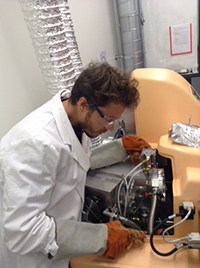WHITAKER INTERNATIONAL FELLOW, 2014

James Wade
- Grantee Type:
- Fellow
- Home Institution:
- Georgia Institute of Technology and Emory University (joint)
- Host Country, Institution:
- Switzerland, University of Zurich
- Year:
- 2014
- Project Title:
- Modeling and Analysis of Cell Signaling in Epithelial-Mesenchymal Transitions of Breast Cancer
- Project Abstract:
Dr. Bodenmiller at the University of Zurich is a leader in the field of signaling network analysis and co-developer of mass cytometry (MC). MC is a new technique that allows simultaneous measurements of many more signaling proteins in single cells than was previously possible. I propose to visit his lab to learn and perform mass cytometry experiments related to cell signaling in epithelial-mesenchymal transitions (EMT) of breast cancer. I will use the data to create and analyze computational models of signaling during EMT. The proposed research will improve our current understanding of metastasis, provide information about drug targets and pave the way toward personalized cancer treatments.
Cells use highly connected signaling networks to process intra- and extracellular information and to make decisions on many crucial processes that drive physiology and development. Faulty regulation of these pathways can lead to severe diseases including cancer, and targeting signaling pathways has become an attractive route of therapy. Complex regulation of signaling pathways lead to complex nonlinear dynamics which, without mathematical analysis, exceed our capacity to understand cellular decision making and rationally design optimal treatment methods. Cell-to-cell heterogeneity adds further complication and necessitates analysis at a single-cell level.
Mass cytometry (CyTOF) enables simultaneous measurement of phosphorylation state of up to 42 proteins in single-cells. Using a time course of ?snap shots? of protein distributions acquired by CyTOF after cells are perturbed, we have developed an ordinary differential equation (ODE) based computational method for modeling and analysis of intracellular signaling dynamics. Our method is unique in that it predicts single-cell trajectories from such snap shot data of fixed cells.
Here I will present ongoing work to validate our computational method. To do this we are creating a novel workflow combining analysis of cells expressing multiple fluorescent kinase translocation reporters (KTRs) with both live-cell time-lapse fluorescent microscopy and imaging mass cytometry analysis.

